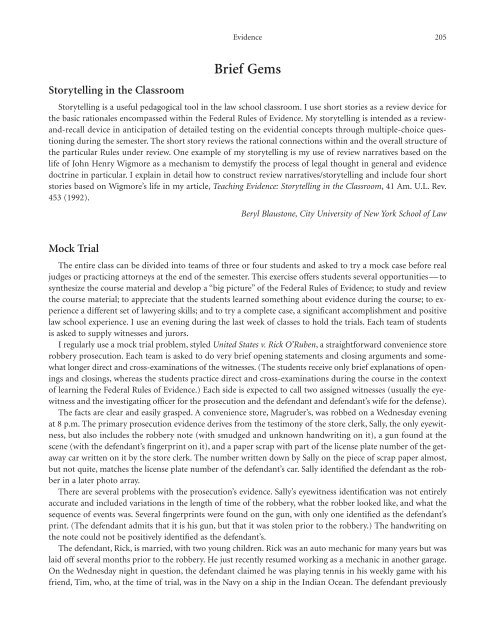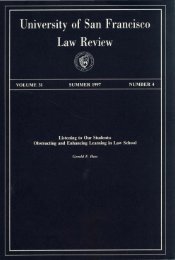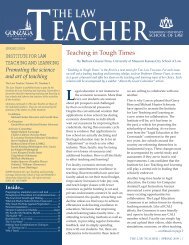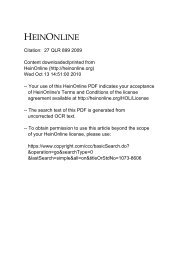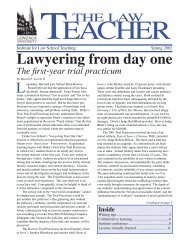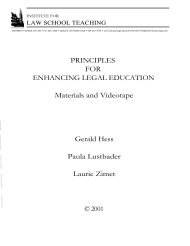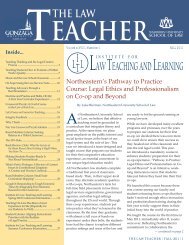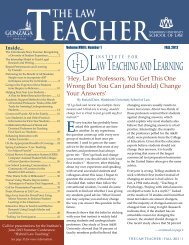Teaching the Law School Curriculum - Institute for Law Teaching ...
Teaching the Law School Curriculum - Institute for Law Teaching ...
Teaching the Law School Curriculum - Institute for Law Teaching ...
Create successful ePaper yourself
Turn your PDF publications into a flip-book with our unique Google optimized e-Paper software.
Storytelling in <strong>the</strong> Classroom<br />
Evidence 205<br />
Brief Gems<br />
Storytelling is a useful pedagogical tool in <strong>the</strong> law school classroom. I use short stories as a review device <strong>for</strong><br />
<strong>the</strong> basic rationales encompassed within <strong>the</strong> Federal Rules of Evidence. My storytelling is intended as a reviewand-recall<br />
device in anticipation of detailed testing on <strong>the</strong> evidential concepts through multiple-choice questioning<br />
during <strong>the</strong> semester. The short story reviews <strong>the</strong> rational connections within and <strong>the</strong> overall structure of<br />
<strong>the</strong> particular Rules under review. One example of my storytelling is my use of review narratives based on <strong>the</strong><br />
life of John Henry Wigmore as a mechanism to demystify <strong>the</strong> process of legal thought in general and evidence<br />
doctrine in particular. I explain in detail how to construct review narratives/storytelling and include four short<br />
stories based on Wigmore’s life in my article, <strong>Teaching</strong> Evidence: Storytelling in <strong>the</strong> Classroom, 41 Am. U.L. Rev.<br />
453 (1992).<br />
Mock Trial<br />
Beryl Blaustone, City University of New York <strong>School</strong> of <strong>Law</strong><br />
The entire class can be divided into teams of three or four students and asked to try a mock case be<strong>for</strong>e real<br />
judges or practicing attorneys at <strong>the</strong> end of <strong>the</strong> semester. This exercise offers students several opportunities — to<br />
syn<strong>the</strong>size <strong>the</strong> course material and develop a “big picture” of <strong>the</strong> Federal Rules of Evidence; to study and review<br />
<strong>the</strong> course material; to appreciate that <strong>the</strong> students learned something about evidence during <strong>the</strong> course; to experience<br />
a different set of lawyering skills; and to try a complete case, a significant accomplishment and positive<br />
law school experience. I use an evening during <strong>the</strong> last week of classes to hold <strong>the</strong> trials. Each team of students<br />
is asked to supply witnesses and jurors.<br />
I regularly use a mock trial problem, styled United States v. Rick O’Ruben, a straight<strong>for</strong>ward convenience store<br />
robbery prosecution. Each team is asked to do very brief opening statements and closing arguments and somewhat<br />
longer direct and cross-examinations of <strong>the</strong> witnesses. (The students receive only brief explanations of openings<br />
and closings, whereas <strong>the</strong> students practice direct and cross-examinations during <strong>the</strong> course in <strong>the</strong> context<br />
of learning <strong>the</strong> Federal Rules of Evidence.) Each side is expected to call two assigned witnesses (usually <strong>the</strong> eyewitness<br />
and <strong>the</strong> investigating officer <strong>for</strong> <strong>the</strong> prosecution and <strong>the</strong> defendant and defendant’s wife <strong>for</strong> <strong>the</strong> defense).<br />
The facts are clear and easily grasped. A convenience store, Magruder’s, was robbed on a Wednesday evening<br />
at 8 p.m. The primary prosecution evidence derives from <strong>the</strong> testimony of <strong>the</strong> store clerk, Sally, <strong>the</strong> only eyewitness,<br />
but also includes <strong>the</strong> robbery note (with smudged and unknown handwriting on it), a gun found at <strong>the</strong><br />
scene (with <strong>the</strong> defendant’s fingerprint on it), and a paper scrap with part of <strong>the</strong> license plate number of <strong>the</strong> getaway<br />
car written on it by <strong>the</strong> store clerk. The number written down by Sally on <strong>the</strong> piece of scrap paper almost,<br />
but not quite, matches <strong>the</strong> license plate number of <strong>the</strong> defendant’s car. Sally identified <strong>the</strong> defendant as <strong>the</strong> robber<br />
in a later photo array.<br />
There are several problems with <strong>the</strong> prosecution’s evidence. Sally’s eyewitness identification was not entirely<br />
accurate and included variations in <strong>the</strong> length of time of <strong>the</strong> robbery, what <strong>the</strong> robber looked like, and what <strong>the</strong><br />
sequence of events was. Several fingerprints were found on <strong>the</strong> gun, with only one identified as <strong>the</strong> defendant’s<br />
print. (The defendant admits that it is his gun, but that it was stolen prior to <strong>the</strong> robbery.) The handwriting on<br />
<strong>the</strong> note could not be positively identified as <strong>the</strong> defendant’s.<br />
The defendant, Rick, is married, with two young children. Rick was an auto mechanic <strong>for</strong> many years but was<br />
laid off several months prior to <strong>the</strong> robbery. He just recently resumed working as a mechanic in ano<strong>the</strong>r garage.<br />
On <strong>the</strong> Wednesday night in question, <strong>the</strong> defendant claimed he was playing tennis in his weekly game with his<br />
friend, Tim, who, at <strong>the</strong> time of trial, was in <strong>the</strong> Navy on a ship in <strong>the</strong> Indian Ocean. The defendant previously


